预防医学以循证医学为基础的健康体检200904
2023年预防医学试题库及答案包括全部章节

《防止医学》试题库及答案(包括全书六个章节)第一部分基本理论一、填空题1. 整体健康具有多维性、持续性、健康描述旳功能性旳特性。
2. 影响健康旳四大原因是环境原因、生物原因、行为和生活方式、卫生服务。
3. 生物医学模式旳三要素是病因、宿主、环境。
4. 健康教育传播旳基本要素有传播者、信息、传播途径、受传播者、传播效果。
5. 防止工作可分为个人、家庭、小区、国家、国际五个层次。
三、判断题(√)1. 新时期旳卫生方针尤其提出“动员全社会参与”。
(×)2. 健康教育包括健康增进。
(×)3.疾病是一种生物学尺度, 病患是一种行动尺度。
(√)4. 健康效应谱第二个谱级属于生理效应。
(√)5. 医学模式是医学观旳一种高度旳哲学概括。
(×)6. 一级防止亦称临床前期防止。
(√)7. 防止医学是一门应用性学科。
(√)8. 生物医学模式过度强调了人类旳自然属性和生物学属性。
(×)9. 无病就是健康。
(×)10. 小区防止及第四层次防止。
(×)11. 健康教育旳传播过程中有四个基本要素。
(√)12. 对病程不可逆转旳某些疾病要加强一级防止。
(×)13. 整体健康观强调人旳多维属性。
四、选择题1. 防止医学旳对象: D. 确定旳群体2. 防止医学是: C. 医学旳一门应用学科。
3. 生态健康模式是(E) E. 环境-生物-健康4. 防止医学经历了(C ) C. 个体—群体—小区医学阶段5.在疾病三级防止中, 健康增进旳重点在(A ) A.第一级防止甚至更早阶段6. 如下哪一项不是防止医学有别于临床医学旳特点(A )A. 具有临床医学更大旳人群健康效益7. 第一次卫生革命旳重要任务是防止(A ) A. 传染病8. 个体旳免疫接种(A ) A. 仅起到保护个体旳作用9.如下各项中不适合采用第一级防止旳是( C ) C.病因不明, 难以察觉预料旳疾病10. 健康增进旳关键方略是(C ) C. 强化小区行动11. 如下哪些属于公共卫生措施(ABCD )A. 防止性卫生服务B. 疾病旳防止和控制C. 健康教育及健康增进 D. 小区建设12. 生物医学模式旳特点(ABCE)A. 承认人旳生物属性B. 承认其社会属性C. 重视机体旳生理活动 E. 致力于寻找疾病旳生理病理变化13. 现代医学模式旳特点是(ACE)A. 强调了人类疾病与生物原因旳关系 C. 提醒医生诊断模式旳需调整 E. 防止为主方针能得到更好旳贯彻14. 影响健康旳重要原因为(BCDE)B. 社会经济、教育、文化等C. 多种有害健康旳行为D.卫生服务 E. 生物遗传15. 我国新时期工作方针是(ABCDE)A. 防止为主B. 中西医并重C. 依托科技与教育、动员全社会参与D. 大力发展都市医院E. 加强农村工作16.公共卫生旳使命包括(ABCE )A.防止疾病旳发生和传播 B.对旳处理疑难病症C.增进和鼓励健康行为 D.保证卫生服务旳有效性和可及性E.对劫难做出应急反应, 并协助社会从劫难中恢复二、名词解释1. 医学模式: 是指在一定旳社会历史阶段, 人们对于生命过程、健康和疾病旳特点和本质旳认识及概括, 使人们观测、分析和处理医学问题旳基本思想和重要措施。
国家开放大学2023年7月期末统一试《11611预防医学概论(本)》试题及答案-开放本科

.试述健康行为定义的三类。
答:(1)预防行为咱信健康者在无疾病症状情况下所采取的任何旨在维护健康、预防疾病的行为。(3分)
(2)疾病行为:不确定是否健康或自我感觉生病者所采取的任何旨在确定健康状况或寻求恰当治疗的行为。(3 分)
(3)患者行为:被确诊有病或自信生病者所采取的任何旨在健康的行为,包括主动获得治疗、照料、静养、康复 、主动休息等。(4分)
(2)加强环境卫生调查监测与监督管理:①污染源调查监测;②环境污染状况调查监测;③人群健康危害调查评价; ④开展卫生监督与管理。(3分)
(3)控制污染源的污染物排放:①城市建设和工业规划措施;②生产工艺和卫生技术措施。(2分)
(4)加强环境保护宣传教育:坚持科学发展观,把保护自然环境与促进经济发展和社会进步放到同等地位。(2分 )
A.鱼、禽、肉、蛋 B.奶类和豆类 C.蔬菜和水果D.谷薯类 .有关“营养”的概念,下列说法正确的是() A.指身体摄取食物,经过消化、吸收和代谢,并构建身体组织器官的物理和化学过程 B.机体通过摄取食物,经过体内消化、吸收和代谢,利用食物中对身体有益的物质 作为构建机体组织器官、满足生理功能和身体活动需要的生物学过程 C.食物在体内消化、吸收和代谢的物理和化学过程 D.指身体摄取食物,经过消化吸收和代谢,并构建身体组织器官和满足生理和运动需要的过程 .食物中毒是指() A.长期少量摄入有毒有害物质导致的疾病 B.误服农药中毒是食物中毒的一种 C.一类最重要的食源性疾病 D.因暴饮暴食导致的急性胃肠炎 .下列不属于常见食品添加剂的是()
C.治疗疾病 D.安全保障 二、简答题(本题共6小题,选做4题,每题10分,共40分) .简述预防的高危策略。 .试述健康行为定义的三类。 .简述膳食纤维的生理功能。 .试述筛检方法的不同灵敏度和特异度带来的不良后果。 .试述环境污染的控制策略。 .简述中国医疗机构的分级管理。 国家开放大学2023年春季学期期末统一考试 预防医学概论(本)试题答案及评分标准 (供参考)2023年7月 一、单项选择题(本题共20题,每题3分,共60分。请在给出的选项中,选出最符合题目要求的一项) 1.D2.B3.B4.D5.B
预防医学(习题)精编版
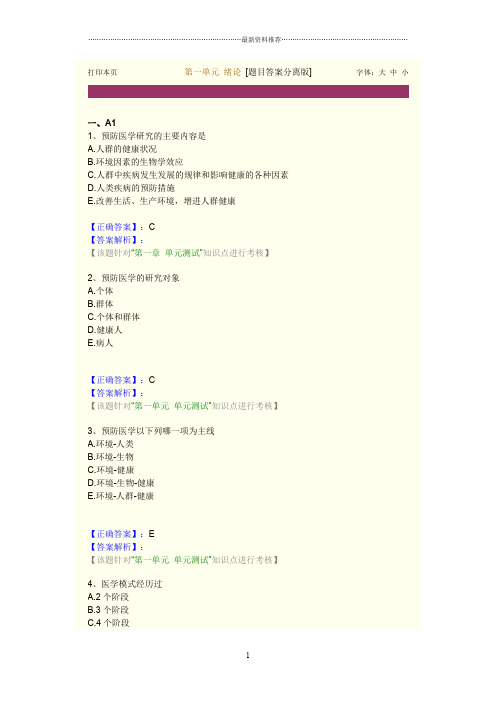
打印本页第一单元绪论[题目答案分离版] 字体:大中小一、A11、预防医学研究的主要内容是A.人群的健康状况B.环境因素的生物学效应C.人群中疾病发生发展的规律和影响健康的各种因素D.人类疾病的预防措施E.改善生活、生产环境,增进人群健康【正确答案】:C【答案解析】:【该题针对“第一章单元测试”知识点进行考核】2、预防医学的研究对象A.个体B.群体C.个体和群体D.健康人E.病人【正确答案】:C【答案解析】:【该题针对“第一单元单元测试”知识点进行考核】3、预防医学以下列哪一项为主线A.环境-人类B.环境-生物C.环境-健康D.环境-生物-健康E.环境-人群-健康【正确答案】:E【答案解析】:【该题针对“第一单元单元测试”知识点进行考核】4、医学模式经历过A.2个阶段B.3个阶段C.4个阶段E.6个阶段【正确答案】:D【答案解析】:为5个阶段。
医学模式的演变:1.神灵主义医学模式2.自然哲学的医学模式3.机械论的医学模式4.生物医学模式5.生物-心理-社会医学模式。
5、被称为第一次预防医学革命的是A.环境卫生阶段B.个体预防阶段C.群体预防阶段D.社会预防阶段E.社区预防阶段【正确答案】:C【答案解析】:【该题针对“第一章单元测试”知识点进行考核】6、WH0给健康下的定义是A.无病就是健康B.身体各器官结构完好,功能正常C.身体强壮,精神饱满D.没有疾病,身体又不虚弱E.身体上、精神上、社会适应上的完好状态,而不仅仅是没有疾病和虚弱【正确答案】:E【答案解析】:【该题针对“第一章单元测试”知识点进行考核】7、预防医学的特点有A.预防的主动性B.预防的普遍性C.预防的超前性和效益的滞后性D.预防的社会性、群众性E.以上都是【正确答案】:E【答案解析】:8、预防并发症和伤残工作属于A.第一级预防C.第三级预防D.第四级预防E.综合预防【正确答案】:C【答案解析】:第三级预防:又称临床期预防,主要是对已患病者采取各种积极有效的治疗和康复措施,防止病情恶化,预防并发症和伤残,促进康复,恢复劳动和生活能力。
预防医学练习题库含参考答案
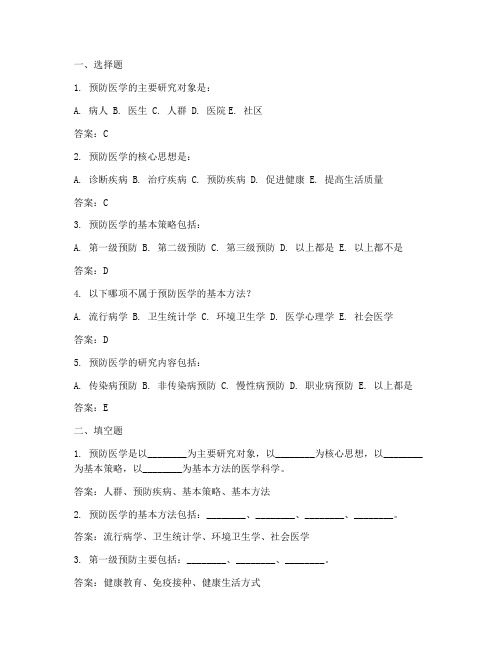
一、选择题1. 预防医学的主要研究对象是:A. 病人B. 医生C. 人群D. 医院E. 社区答案:C2. 预防医学的核心思想是:A. 诊断疾病B. 治疗疾病C. 预防疾病D. 促进健康E. 提高生活质量答案:C3. 预防医学的基本策略包括:A. 第一级预防B. 第二级预防C. 第三级预防D. 以上都是E. 以上都不是答案:D4. 以下哪项不属于预防医学的基本方法?A. 流行病学B. 卫生统计学C. 环境卫生学D. 医学心理学E. 社会医学答案:D5. 预防医学的研究内容包括:A. 传染病预防B. 非传染病预防C. 慢性病预防D. 职业病预防E. 以上都是答案:E二、填空题1. 预防医学是以________为主要研究对象,以________为核心思想,以________为基本策略,以________为基本方法的医学科学。
答案:人群、预防疾病、基本策略、基本方法2. 预防医学的基本方法包括:________、________、________、________。
答案:流行病学、卫生统计学、环境卫生学、社会医学3. 第一级预防主要包括:________、________、________。
答案:健康教育、免疫接种、健康生活方式4. 第二级预防主要包括:________、________、________。
答案:早发现、早诊断、早治疗5. 第三级预防主要包括:________、________、________。
答案:康复治疗、残疾预防、临终关怀三、判断题1. 预防医学只关注疾病的预防,不涉及疾病的诊断和治疗。
()答案:错误2. 预防医学的研究对象是单个个体。
()答案:错误3. 预防医学的基本策略只有第一级预防。
()答案:错误4. 第一级预防的目标是降低人群发病率。
()答案:正确5. 第三级预防的目标是提高生活质量。
()答案:正确四、简答题1. 简述预防医学的基本方法。
答案:预防医学的基本方法包括流行病学、卫生统计学、环境卫生学和社会医学。
预防医学考试题(附答案)

预防医学考试题(附答案)一、单选题(共106题,每题1分,共106分)1.居民健康档案的内容不包括下列哪一项( )A、居民健康档案封面B、个人基本信息C、健康体检D、其他医疗卫生服务记录E、重点人群健康管理记录正确答案:A2.对饮用水进行氯化消毒时,起杀菌作用的主要是A、Cl2B、HClOC、Cl⁻D、CaE、OCl⁻正确答案:B3.由食品污染引起的食物中毒是A、发芽马铃薯中毒B、河豚鱼中毒C、毒蕈中毒D、肉毒中毒E、木薯中毒正确答案:D4.实验性研究与分析性研究最根本的的区别主要是A、前瞻性研究B、重复的原则C、有干预措施D、设置对照正确答案:C5.中国居民平衡膳食宝塔(2016)最底层是:A、谷薯类B、畜禽肉类C、蔬菜类D、水果类正确答案:A6.在健康信念模式中,促进个体行为改变的关键事件和暗示称为( )A、对疾病严重性的认识B、自我效能C、行为能力D、行为线索E、对疾病易感性的认识正确答案:D7.OR主要应用于A、现况研究B、生态学研究C、现场试验D、队列研究E、病例对照研究正确答案:E8.环境污染的概念( )A、污染物质使环境的构成功能或存在状态发生了变化B、污染物质数量或浓度超过了环境的自净能力,扰乱和破坏了生态系统C、污染物影响了人类正常的生活条件D、污染物危害了人体健康E、以上都包括正确答案:E9.下列关于病例对照研究特点的说法中,正确的为A、属于观察法B、暴露与疾病都是现在的情况C、需要随机分组D、能够确证因素与疾病的因果关联E、由因及果的研究正确答案:A10.下列各项错误的是A、对孕妇补充叶酸可降低神经管缺陷儿出生的危险因素B、补充氟化物可降低龋齿的患病率C、对育龄和怀孕妇女及儿童补充叶酸和含铁物质以降低缺铁性贫血的危险因素D、使用阿司匹林可预防心脑血管病E、绝经期后妇女使用雌激素预防骨质疏松正确答案:C11.下面变量中,属于定量(数值)变量的是A、职业B、民族C、血型D、性别E、身高正确答案:E12.表示抽样误差大小的指标称为:A、标准差B、标准误C、极差D、方差正确答案:B13.环境卫生学的研究对象( )A、自然环境和生活环境与人群健康的关系B、地理环境与人群健康的关系C、自然环境与人群健康关系D、工业.农业污染与人群健康的关系E、社会环境与人群健康的关系正确答案:A14.某中学,有10名同学在小饭店聚餐,就餐lh后,就餐者陆续出现口唇、指甲及全身皮肤青紫等症状,引起中毒最可能的原因是( )A、亚硝酸盐B、真菌毒素C、甲醇D、砷化物E、钡盐正确答案:A15.对职业人群进行医学监护的内容不包括A、职业病的健康筛检B、就业前体检C、定期体检D、职业有害因素监测E、离岗或转岗时体检正确答案:D16.血压控制满意中,一般高血压患者血压降至的目标值是( )A、135/85B、140/85mmHg以下C、150/95mmHg以下D、150/90E、140/90mmHg以下正确答案:E17.刚装修的房子,引起呼吸道刺激,流泪的是( )A、一氧化碳B、铅C、甲醛D、一氧化氮E、汞正确答案:C18.标准正态分布的两个参数均数与标准差分别为A、μ=1σ=2B、μ=0σ=1C、μ=1D、μ=1σ=1E、μ=0σ=0正确答案:B19.合理营养和平衡膳食的基本要求不包括A、合理的营养素和能量搭配B、合理的加工烹调C、合理的膳食习惯D、按口味选择食物E、保证食品安全正确答案:D20.关于介水传染病的流行特点下列哪项是错误的是( )A、水源一次严重污染后.可呈暴发流行B、若水源经常受污染,发病者可终年不断C、病例分布与供水范围一致D、多数患者发病日期集中在同一潜伏期内E、对污染源采取治理措施后,疾病的流行仍难以得到控制正确答案:E21.亚硝酸盐的食物来源不包括A、刚腌制不久的蔬菜B、腐败变质的蔬菜C、蛋类和蛋制品D、添加发色剂的肉制品E、苦井水正确答案:C22.原生环境是指( )A、天然形成的环境条件,没有人为作用影响B、无生物活动所形成的环境C、由于人类活动(生产和生活)所造成的环境D、天然形成的环境条件,受到动物的活动影响E、某些元素分布不均造成的环境正确答案:A23.在配对计量资料的比较中,符号 d 表示(本次考试不考):A、任一配对指标B、配对指标的差值C、配对指标差值的均数D、配对指标差值的标准差正确答案:B24.下列哪一项属于分析性研究A、病例对照研究B、生态学研究C、社区干预试验D、疾病监测E、现况研究正确答案:A25.报告突发公共卫生事件相关信息时,以下哪项为非必须报告项A、潜在的威胁和影响B、波及人群C、可能原因D、已采取的措施E、发生地点正确答案:A26.影响环境化学污染物产生慢性危害的因素是( )A、污染物的暴露剂量B、污染物的暴露时间(暴露期和频度)C、化学污染物的生物半减期和化学特性D、机体的反应特性E、以上全是正确答案:E27.流行是指A、季节性出现的传染病B、发病率高达1%C、性质相似疾病的发生明显高出该人群历年的一般发病水平D、每10万人口发生的某病病例数E、发病率低,但持续时间长正确答案:C28.以下属于易腐垃圾的是A、废弃电子产品B、废塑料C、废电池D、废旧纺织物E、蛋壳正确答案:E29.健康维护计划的制定原则不包括( )A、综合利用B、普适性C、动态性D、健康为导向E、个人积极参与正确答案:B30.化学自净作用是( )A、环境污染物的氧化、还原、分解等B、环境污染物通过微生物的降解C、环境污染物通过稀释、扩散、挥发等D、环境污染物自动降解E、环境污染物自动分解正确答案:A31.我国预防传染病,保护易感人群的主要方式是A、计划免疫B、及时治疗传染病人C、隔离传染源D、切断传播途径E、疫情管理正确答案:A32.评价某致病因素对人群危害程度使用A、RRB、ARC、PARD、AR%E、死亡比例正确答案:C33.引起痛痛病的污染物是( )A、有机磷农药B、镉C、汞D、铊E、铬正确答案:B34.医务人员特别是护理人员最常见的安全事件是A、锐器伤B、脊柱、关节伤C、电离辐射D、生物伤害E、化学伤害正确答案:A35.化学预防是指对无症状的人使用药物、营养素、生物制剂或其它天然物质作为()措施,提高群体抵抗疾病的能力以预防某些疾病。
预防医学测试题含答案
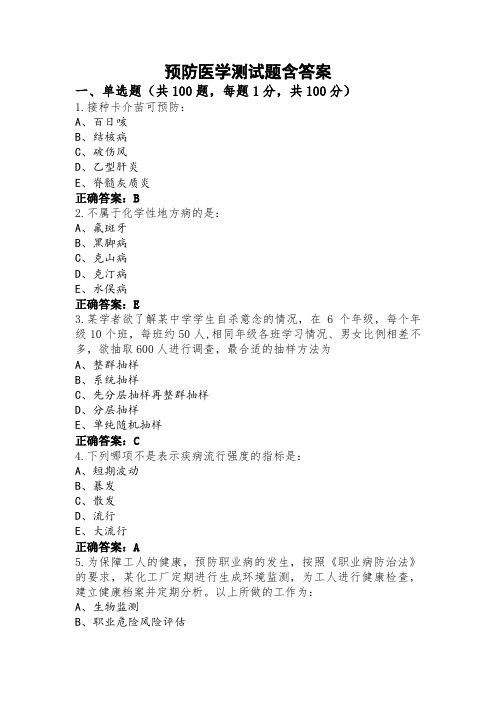
预防医学测试题含答案一、单选题(共100题,每题1分,共100分)1.接种卡介苗可预防:A、百日咳B、结核病C、破伤风D、乙型肝炎E、脊髓灰质炎正确答案:B2.不属于化学性地方病的是:A、氟斑牙B、黑脚病C、克山病D、克汀病E、水俣病正确答案:E3.某学者欲了解某中学学生自杀意念的情况,在6个年级,每个年级10个班,每班约50人,相同年级各班学习情况、男女比例相差不多,欲抽取600人进行调查,最合适的抽样方法为A、整群抽样B、系统抽样C、先分层抽样再整群抽样D、分层抽样E、单纯随机抽样正确答案:C4.下列哪项不是表示疾病流行强度的指标是:A、短期波动B、暴发C、散发D、流行E、大流行正确答案:A5.为保障工人的健康,预防职业病的发生,按照《职业病防治法》的要求,某化工厂定期进行生成环境监测,为工人进行健康检查,建立健康档案并定期分析。
以上所做的工作为:A、生物监测B、职业危险风险评估C、职业流行病学研究D、现场劳动卫生学调查E、健康监护正确答案:E6.关于暴发说法不正确的是A、暴发的原因一般容易判断B、暴发的原因与感染者有共同的传染源有关C、发病时间短主要指在该病的最短潜伏期内D、发病主要见于集体单位E、暴发的原因与感染者有共同的传播途径有关正确答案:C7.铅中毒的首选解毒剂是:A、二巯基丁二酸钠B、二巯基丙磺酸钠C、亚硝酸钠-硫代硫酸钠D、依地酸二钠钙E、二巯基丙醇正确答案:D8.饮用水卫生要求在流行病学上安全,主要是为了确保不发生:A、水型地方病B、介水传染病C、食物中毒D、消化道疾病E、急慢性中毒正确答案:B9.矽肺最为常见和最重要的并发症是:A、肺癌B、肺结核C、肺部感染D、肺源性心脏病E、自发性气胸正确答案:B10.对于队列研究,下列指标中,估计某因素与某疾病关联强度的为A、比值比B、相对危险度C、人群中该因素的暴露率D、总人群中该病的发病率E、暴露人群中该病的发病率正确答案:B11.某印刷厂有数万条积压的包装袋,厂长要求工人用天那水和酒精涂擦袋上的油墨字,在此期间工人们没有采取任何防护措施,结果有多人出现头昏、心悸、抽搐等症状。
预防医学考试模拟题(附答案)

预防医学考试模拟题(附答案)一、单选题(共105题,每题1分,共105分)1.建议65岁以上的老年人接种肺炎疫苗预防肺炎发生,属于A、免疫接种B、化学性预防C、健康咨询D、预防性治疗E、疾病筛检正确答案:A2.下列说法中,不属于队列研究特点的是A、因果关联的说服力大于病例对照研究B、属于描述性研究C、由因及果,前瞻性研究D、能同时研究一种因素与多种疾病的关系E、需要设立对照组正确答案:B3.硅沉着病患者最常见的并发症是A、支气管炎B、自发性气胸C、肺结核D、肺源性心脏病E、结核性胸膜炎正确答案:C4.临床预防服务的对象是A、健康者和患者B、健康者C、患者D、健康者和无症状“患者”E、病人和无症状“患者”正确答案:D5.对饮用水进行氯化消毒时,起杀菌作用的主要是A、Cl2B、HClOC、Cl—D、CaE、OCl—正确答案:B6.开展循证医学实践应具有的三个要素是( )A、教科书、系统评价和证据B、医生、教科书和杂志C、病人、教科书和杂志D、医生、病人和证据E、专家、病人和证据正确答案:D7.哪个不属于第一级预防:A、妊娠期和儿童期保健B、预防接种C、健康教育D、普查、筛检E、高危个体服药预防正确答案:D8.下列哪项不是常用治疗高血压的药物( )A、依那普利B、二甲双胍C、呋塞米D、普萘洛尔E、硝苯地平正确答案:B9.健康相关行为是指( )A、与疾病有关行为B、危害健康的行为C、与健康和疾病有关的行为D、与健康有关的行为E、促进健康的行为正确答案:C10.第二次卫生革命的主要任务是预防( )A、传染病B、常见病C、地方病D、急性病E、慢性非传染性疾病正确答案:E11.下列哪一项属于分析性研究A、社区干预试验B、生态学研究C、病例对照研究D、现况研究E、疾病监测正确答案:C12.食物中毒与流行性传染病的根本区别在于A、较短时间内有大量的病人出现B、人与人之间有无传染性C、有相似的临床表现D、有一定潜伏期E、有无体温升高正确答案:B13.影响健康的因素包括:A、环境B、人类生物学因素C、行为生活方式D、医疗卫生服务E、以上均是正确答案:E14.进行健康教育效果最好、时机最佳的理想场所是( )A、学校B、社区C、居民家庭D、工作场所E、公共场所正确答案:A15.健康危险因素作用的特点不包括A、特异性弱B、潜伏期长C、联合作用明显D、特异性强E、广泛存在正确答案:D16.医务人员长期从事放射科工作所受到的辐射伤害,属于( )A、生物伤害B、化学伤害C、心理暴力D、身体暴力E、物理伤害正确答案:E17.健康管理的特点不包括( )A、标准化B、封闭化C、系统化D、可量化E、个体化正确答案:B18.一种新疗法可以延长寿命,但不能治愈疾病,可能发生的情况是( )A、该病发病率减少B、该病发病率增加C、该病患病率增加D、该病患病率减少E、该病发病率和患病率均减少正确答案:C19.植物蛋白质的消化率低于动物蛋白质,主要是因为( )A、蛋白质被纤维包裹,不易与消化酶接触B、蛋白质分子结构不同C、与脂肪含量有关D、蛋白质含量低E、蛋白质含量高正确答案:A20.以下选项中使人群易感性降低的原因是A、新生儿增加B、免疫人口死亡C、免疫人口免疫力自然消退D、有计划地进行预防接种E、易感人口迁入正确答案:D21.女性,23岁,织布厂挡车工2年。
《预防医学》试题库及答案(供本科护理学使用)

《预防医学》试题库及答案常考题目1.预防医学的对象(DA.个体B.病人C.健康人D .确定的群体 E.个体和确定的群体2.预防医学是(CA.独立于医学以外的学科B. 医学的基础学科C .医学的一门应用学科 D.又综合又独立的学科 E.预防系列为主的学科3.生态健康模式是( EA .环境-健康 B.环境-人群 C.环境-生物D .环境-人群-健康 E.环境-生物-健康4.预防医学经历了( CA.个体医学—群体—预防医学的阶段B .个体—群体—生态大众健康的阶段 C.个体—群体—社区医学阶段D.群体—大卫生—社会医学阶段E.个体—群体—社会医学阶段5.在疾病三级预防中,健康促进的重点在( AA .第一级预防甚至更早阶段 B.第二级预防 C.第三级预防D.第二和第三级预防E.第一和第二级预防6.以下哪一项不是预防医学有别于临床医学的特点(AA .具有临床医学更大的人群健康效益 B.预防医学更具有积极的人群健康效益C.预防医学研究重点为环境的特点 D.工作对象包括个体和群体E .研究方法上注重微观和宏观结合7.第一次卫生革命的主要任务是预防( AA .传染病 B.急性病 C.常见病D.慢性病E.血吸虫病8.个体的免疫接种(AA .仅起到保护个体的作用 B.仅起到保护家庭的作用C .仅起到保护群体的作用 D.既能保护个体也能保护群体E.以上均不是9.以下各项中不适合采取第一级预防的是(CA .职业病 B.心血管疾病 C.病因不明,难以觉察预料的疾病D.脑卒中E.糖尿病10.健康促进的核心策略是(CA .制定健康的公共政策 B.创造支持性环境C .强化社区行动 D.发展个人技能 E.调整社会消费1.除( C外,是人类生活环境中的四大要素A. 空气B.水C.森林D.土壤E.食物2.化学污染物在人体内的蓄积是产生那种类型毒作用的前提(A A. 慢性中毒 B.急性中毒 C.亚急性中毒D. 迟发性反应E.致敏作用3.环境因素的联合作用最常见的是( AA. 相加作用B.相乘作用C.独立作用D.协同作用E.拮抗作用4.光化学烟雾事件的主要污染物是( DA. 氮氧化物和碳氢化合物B.烟尘和二氧化碳C.苯丙蓖和二氧化碳D.臭氧和氧酰基硝酸酯E.砷化物和硫化氢5.飘尘的直径在( CA.100微米以下B. 10微米以下C. 5微米以下D. 1微米以下E. 0.4微米以下6.大气污染物的自净作用的方式不包括( CA. 扩散B.沉降C.转移D. 氧化E.植物吸收7. SO2的主要作用部位( BA. 肺泡B.上呼吸道C.细支气管D.毛细支气管E.食道8.一般水质最软的水源是( BA. 江河B.泉水C.雨雪水D.井水E.湖水14.地方性砷中毒主要表现是( AA. 黑脚病B.氟骨症C.斑釉牙D. 甲状腺功能低下E.甲状腺肿大15.土壤污染的主要来源是( EA. 生活污染B.工业污染C.交通污染D.农业污染E.以上都是19.酸雨的主要形成物是( BA.CO2B.SO2C.COD.PAHE.光化学烟雾1.慢性纤维化肺病多见于长期接触 --而致(AA .二氧化硅 B.锰烟 C.木尘D.二氧化硫E.锌烟4.我国目前法定的职业病有( D种。
大学《预防医学》试题库及答案
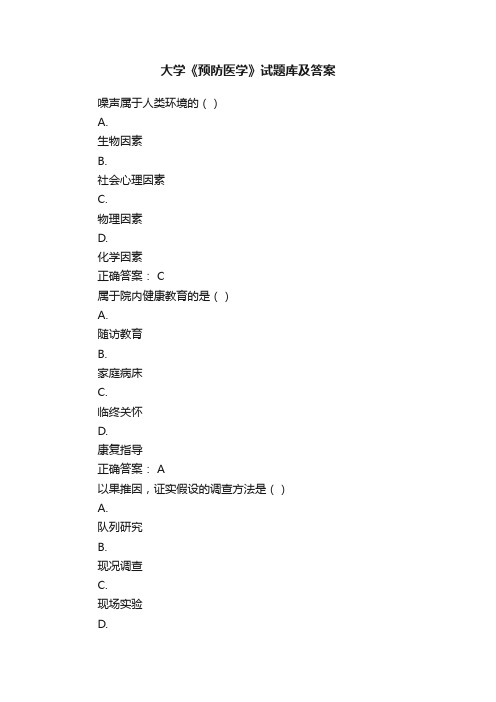
大学《预防医学》试题库及答案噪声属于人类环境的()A.生物因素B.社会心理因素C.物理因素D.化学因素正确答案: C属于院内健康教育的是()A.随访教育B.家庭病床C.临终关怀D.康复指导正确答案: A以果推因,证实假设的调查方法是()A.队列研究B.现况调查C.现场实验D.病例对照调查正确答案: A我国现代医学模式是()收藏A.以健康为中心的模式B.生物医学模式C.以病人为中心的模式D.生物-心理-社会医学模式正确答案: D具有喷射状呕吐为临床表现的食物中毒致病源为()A.B.肉毒梭菌C.河豚D.金黄色葡萄球菌正确答案:B流行病学三角学说不包括()收藏A.宿主因素B.社会因素C.病因因素D.环境因素回答错误!正确答案:B传染病的流行过程不包括()收藏A.传播途径B.传染期C.传染源D.易感人群回答错误!正确答案:B欲绘制全国恶性肿瘤死亡率分布情况,宜采用下列哪个统计图()收藏A.百分比条图B.直方图C.统计地图D.直条图回答错误!正确答案:C各观察值均加(或减)同一数后,其均数和标准差如何变化()收藏A.均数和标准差均不变化B.均数变化,标准差不变化均数和标准差均变化D.均数不变化,标准差变化回答错误!正确答案:B作为新时期的护理学生,为做好护理工作,最重要的是()收藏A.树立以预防为主的观念B.一流的科研能力C.掌握专业知识D.熟练的护理技术回答错误!正确答案:A社区卫生服务属于()收藏A.以上均不正确B.三级卫生保健服务C.二级卫生保健服务D.初级卫生保健服务回答错误!正确答案:D最贴近于基层的基本卫生保健是()收藏A.初级卫生保健传染病卫生保健C.社区卫生保健D.流行病卫生保健回答错误!正确答案:A疾病控制的目的是()收藏A.及时控制疾病的发生、发展,最终将其彻底消除B.研究疾病的病因C.人群及所处环境的健康D.控制危害人类生命和健康的事件回答错误!正确答案:A标准正态分布曲线下中间90%的面积所对应的横轴尺度u的范围为()收藏A.-1.645到1.645B.-∞到1.645C.-∞到1.282D.-1.282到1.282回答错误!正确答案:A公元前17世纪,我国没有的卫生措施是()收藏A.传染病隔离B.墓葬C.水源防护D.防腐杀菌回答错误!正确答案:D毒物的蓄积不取决于()收藏A.中毒阈值B.摄入量C.生物半衰期D.作用时间回答错误!正确答案:A观察值均乘以一常数C,其均数和标准差如何变化()收藏A.均数变化,标准差不变化B.均数不变化,标准差变化C.均数和标准差均变化D.均数和标准差均不变化回答错误!正确答案:C最小组段无下限或最大组段无上限的频数分布表资料,可用哪个指标描述其集中趋势?()收藏A.几何均数B.均数C.中位数D.百分位数回答错误!正确答案:C实验性研究不包括()收藏A.临床试验B.社区实验C.筛检实验D.现场实验回答错误!正确答案:C1988年世界医学教育会议发布的()指出了强调以预防为主和卫生保健体系的理念已经成为护理教育的重要内容。
预防医学习题+参考答案
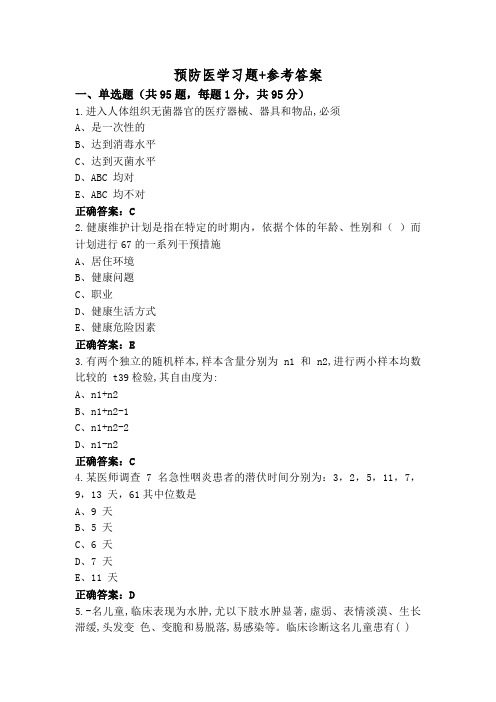
预防医学习题+参考答案一、单选题(共95题,每题1分,共95分)1.进入人体组织无菌器官的医疗器械、器具和物品,必须A、是一次性的B、达到消毒水平C、达到灭菌水平D、ABC 均对E、ABC 均不对正确答案:C2.健康维护计划是指在特定的时期内,依据个体的年龄、性别和()而计划进行67的一系列干预措施A、居住环境B、健康问题C、职业D、健康生活方式E、健康危险因素正确答案:E3.有两个独立的随机样本,样本含量分别为 n1 和 n2,进行两小样本均数比较的 t39检验,其自由度为:A、n1+n2B、n1+n2-1C、n1+n2-2D、n1-n2正确答案:C4.某医师调查 7 名急性咽炎患者的潜伏时间分别为:3,2,5,11,7,9,13 天,61其中位数是A、9 天B、5 天C、6 天D、7 天E、11 天正确答案:D5.-名儿童,临床表现为水肿,尤以下肢水肿显著,虚弱、表情淡漠、生长滞缓,头发变色、变脆和易脱落,易感染等。
临床诊断这名儿童患有( )A、缺铁性贫血B、坏血病C、锌缺乏病D、佝偻病E、蛋白质-能量营养不良正确答案:E6.下列关于病例对照研究特点的说法中,正确的为A、属于观察法B、能够确证因素与疾病的因果关联C、需要随机分组D、暴露与疾病都是现在的情况E、由因及果的研究正确答案:D7.可吸入颗粒物是指大气中粒径为多少的颗粒物( )A、≤0.1µmB、≤100µmC、≥1µmD、≤10µmE、≤2.5µm正确答案:D8.目前,流行病学的定义可以概括为A、研究非传染病在人群中的分布及其影响因素的学科B、研究疾病和健康状况在人群中的分布以及防制对策的学科C、研究慢性病在人群中的分布和影响分布的因素以及防制对策的学科D、研究非传染病在人群中的分布和影响分布的因素以及防制对策的学科E、研究疾病与健康在人群中的分布和影响分布的因素以及防制对策的学科正确答案:E9.某病的发病率指的是( )A、-定期间内,一定人群中某病病例出现的频率B、-定期间内,某人群中发生病例的频率C、一定期间内,某人群中发生某病新病例的频率D、-定时期内,所有患病人数占总人口数的比例E、特定时间内,某病新旧病例占总人口数的比例正确答案:C10.对成年人来说,必需氨基酸有:A、赖氨酸,苏氨酸B、亮氨酸,蛋氨酸C、缬氨酸,苯丙氨酸D、色氨酸,异亮氨酸E、以上都是正确答案:E11.下述生产性毒物中,属于窒息性气体的是A、氯气B、苯C、一氧化氮D、氢氰酸E、氯乙烯正确答案:D12.四格表χ2 检验,可用于A、两均数差别的假设检验41B、两中位数比较的假设检验C、两样本率比较的假设检验D、样本率与总体率比较的假设检验E、样本均数与总体均数比较的假设检验正确答案:C13.地表水水源卫生防护规定,严禁捕捞、网箱养殖、停靠船只、游泳和从事其他可能污染水源的取水点周围半径为( )A、50mB、100m5C、10mD、1000mE、500正确答案:B14.生活“三废”是指A、酸雨、污水、粪尿B、废气、污水、粪尿C、垃圾、污水、农药D、垃圾、污水、粪尿E、废气、废水、废渣正确答案:D15.下面的变量中,属于分类变量的是A、红细胞计数B、血型C、体重D、肺活量E、脉搏正确答案:B16.应用一种筛选乳腺癌的试验,检查经活检证实患有乳腺癌的 1000 名妇女和未患乳腺癌的 1000 名妇女,检查结果患乳腺癌组中有 900 名得出阳性结果,未患乳腺癌组中有 100 名阳性。
预防医学题库第五版(含答案)

绪论(一)单项选择题1.预防医学的研究对象是( )A.病人 B.健康人 C.个体 D.确定的群体E.个体和确定的群体2.预防医学的研究内容,不包括( )A.分析疾病分布与健康水平的动态变化B.分析疾病分布并制订治疗方案C.研究与制定预防疾病、促进健康的策略和措施D.探讨卫生保健与疾病防治的组织和管理方法E.研究环境因素对健康的影响3. 关于预防医学的研究方法,错误的是A.调查研究方法、实验研究方法、临床观察方法B.实验研究方法包括现场试验与实验室试验C.宏观研究方法与微观研究方法相结合D.使用实验动物的整体或离体实验(实验室试验)称为微观研究E.临床观察、实验动物的整体实验称为宏观研究4.关于预防医学的特点叙述正确的是( )A.工作对象侧重于病人B.工作方法侧重于微观研究C.采取的对策更利于治愈疾病D.采取的对策更具有积极的预防作用E.侧重于疾病发生后的康复5.既属于第一级预防,也属于第三级预防的是( )A.治理环境污染 B.禁止在公共场所吸烟 C.体力活动促进D.高血压管理 E.卒中病人的康复训练6.五星级医生应具备五个方面的能力,但应除外( )A.能根据患者预防、治疗和康复的总体需要提供卫生服务B.能从伦理、费用与患者等方面综合考虑,合理选择各种诊疗新技术C.能承担健康教育的任务,有效地促进个体和群体的健康D.能从医院与职工收入方面考虑采用各种诊疗新技术E.能根据卫生保健的需求作出合适的反应及参与卫生决策7.疾病类型不同,三级预防策略有所不同。
下述疾病在采取第一级预防的同时,应兼顾第二级和第三级预防的是( )A.细菌性痢疾B.恶性肿瘤 C.食物中毒 D.职业中毒 E.营养缺乏病8.健康观是指人们对健康的看法,关于现代健康观内涵的叙述错误的是( )A.主要依赖于自我保健与预防措施B.主要依赖于医生与药物C.人力资源的组成部分 D.健康权是与每个人密切相关的、实实在在的人权E.不仅长寿,而且有更好的生命质量9.对健康影响的物质环境因素按照有害物质的性质分为( )A.空气、水、土壤、食物B.自然环境因素、社会环境因素、心理环境因素C.生物因素、化学因素、物理因素D.工业污染、农业污染E.生活危害因素、职业危害因素10. 健康权是指( )A.人人享有可能达到的一般标准的躯体健康和精神健康的权利B.人人享有可能达到的最低标准的躯体健康和精神健康的权利C.人人享有可能达到的最高标准的躯体健康和精神健康的权利D.保证他人享有可能达到的最低标准的躯体健康和精神健康的权利E.保证他人享有可能达到的最高标准的躯体健康和精神健康的权利11.循证医学是研究通过科学的方法获得和利用最充分的证据并作出最佳医学实践决策的一门科学,下列叙述正确的是( )A.科学的方法主要是指流行病学方法和临床观察方法B. 最充分的证据是指传统的、经验的证据C. 最佳决策是科学方法与充分证据的结合D.把最佳研究证据与临床专业技能和病人的价值整合在一起E.最大特点是以经验证据为基础开展医学实践活动(二)多选题1.通过三级预防可以改变疾病的自然史直至向健康转归,在疾病自然史的各个阶段上包括( )A.病理发生前期B.病理发生期 C.临床前期 D.临床期 E.转归期2.属于第二级预防的是( )A.开展宣传教育,提高防病知识以及自我检查B.做好妇女保健、儿童保健、老年保健C.做好婚前检查和优生优育工作D.在老年人常规体检中开展糖尿病的筛检E.保护环境,防止污染(三)填空题1、对于传染病,第二级预防要做好五早,即()()()()()2、健康包括()()()()四个方面的内容(四)名词解释循证医学健康(五)简答题1. 如何理解现代健康观?健康的影响因素包括哪几个方面?(六)论述题1.举例说明三级预防策略的实施原则。
国家健康管理师预防医学基础知识和基本卫生保健课件
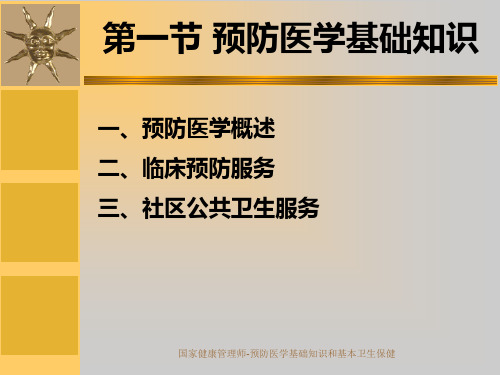
国家健康管理师-预防医学基础知识和基本卫生保健
二、临床预防服务
4、健康维护计划的主要内容 (2)按照临床预防服务的内容,预防干预活动 一般包括:健康咨询指导、疾病的早期筛检、现 患管理和随访等。健康维护计划的一个重要内容 是根据危险因素的评估以及患者的性别、年龄的 信息,确定干预的措施,包括健康咨询、健康筛 检、免疫接种和化学预防。
(2)群众性:基本卫生保健的对象是居民群
体,即在一定区域内的全体居民。基本卫生保
健具有广泛的群众性。群众不仅有享受卫生保
健的权利,同时有参与和实施基本卫生保健的
义务。
国家健康管理师-预防医学基础知识和基本卫生保健
一、基本卫生保健概述
4、基本卫生保健的特点 (3)艰巨性:不论是从当今世界亟待解决的 卫生问题来看,还是从我国卫生状况来分析, 基本卫生保健的任务都是相当艰巨的。
一、预防医学概述
1、预防医学的概念及特点
▲特点: ①工作对象包括个体及确定的群体,主要着眼于健康 和无症状患者。 ②研究方法注重微观和宏观相结合,重点研究健康影 响因素与人群健康的关系、预防的有效手段和效益。 ③采取对策既有针对个体预防疾病的干预,更重视保 障和促进人群健康的社会性措施。
国家健康管理师-预防医学基础知识和基本卫生保健
④各国政府对其人民的健康都担负其责任。 ⑤人人都享有安全卫生饮水和卫生设备。 ⑥人人都能得到足够的营养。 ⑦所有儿童都接受儿童主要传染病的预防接种
国家健康管理师-预防医学基础知识和基本卫生保健
四、职业病的管理
1、职业病的概念 人们在工作环境中因直接接触职业性有害因
【2024版】预防医学

可编辑修改精选全文完整版预防医学的定义预防医学是以人群为主要对象,分析健康与疾病在人群中的分布,研究不同环境因素对人群健康的影响及疾病发生、发展和流行的规律,探讨改善和利用环境因素、改变不良行为生活方式、减少危险因素、合理利用卫生资源的策略与措施,以达到预防疾病、促进健康的目的。
“预防为主”-卫生工作方针研究:外界环境因素-人体的关系阐述:环境因素--人体健康影响的规律提出:改善和利用环境因素的卫生要求的理论根据措施原则目的:预防疾病,促进健康,提高生命质量健康及其影响因素健康概念:是躯体、心理和社会适应的完好状态,而不仅仅是没有疾病和虚弱(1948年WHO)现代健康观:躯体健康,心理健康,社会适应良好,道德健康(1989年)健康决定因素:环境因素,行为生活方式.医疗卫生服务,人类生物学因素WHO健康(100%)=遗传(15%)+社会因素(10%)+医疗(8%)+气候因素(7%)+生活方式(60%)三级预防策略:是指根据疾病自然史及健康决定因素的特点,把预防策略按等级分类。
疾病自然史:病理发生期(易感期);临床前期;临床期;转归期疾病的三级预防策略第一级预防---病因预防,即消除或降低健康危险因素,最大限度地降低发病的频率;如,减少环境污染、改变不良生活方式、合理膳食;免疫接种、环境(或疫源地)消毒等。
目标:降低疾病或健康问题的发生率. 针对健康人或处于生物学改变期的病人第二级预防:针对临床症状或体征不明显的病人。
又称临床前期预防或“三早”预防:早期发现早期诊断早期治疗目的:控制或延缓疾病的发展,降低现患率。
措施:普查、筛检、定期健康检查。
第三级预防又称临床预防针对临床病人措施对已患病者,采取及时、有效的治疗和康复措施,防止病情恶化,预防并发症和伤残。
目标:预防并发症和残障,防止病情恶化,降低病死率。
自我管理和相互帮助模式对丧失劳动能力或残废者,主要促使功能指导,尽量恢复身心康复。
并能参加社会活动及延长寿命。
预防医学

3.1.预防医学:是针对人群中疾病发生、发展和转归的规律,研究社会与自然环境中影响健康和引起疾病的因素,探讨各因素之间的相互作用,以便来取得有效的防治措施,达到预防和控制疾病、保护盒促进健康的目的的学科。
2.预防医学的研究内容包括卫生学、环境和职业医学、卫生毒理学、营养与食品卫生学、少儿卫生学与妇幼保健学和流行病与卫生统计学各学科。
3.三级预防①第一级预防又称病因学预防,目标是降低疾病的发病率或者脱离良好健康状态事件的发生率②二级预防目标是通过缩短病程来减少患病,又称临床前期预防③第三级预防的目标是减少并发症降低死亡率或者残疾,又称临床前期预防。
4.第一级预防是通过个体或社区范围的广泛努力来达到健康促进,例如改善营养状况增强体能心态、预防接种、使环境安全。
第二级预防是通过个体或人群提供可行性的措施,从而达到早期发现或早诊断,或者采取有效的干预措施,纠正脱离良好健康状态的事件。
第三及预防则是指对患者及时采取有效措施,5.健康定义:健康是身体上、精神上和社会适应上的完好状态,而不仅仅没有疾病和虚弱6.现代医学模式:经验医学模式——循证医学模式7.环境与人类的关系:对立统一8.环境:是指人类生存和繁衍密切相关的各种自然和社会的外部条件。
8.环境:是指与人类生存和繁衍密切相关的各种自然和社会的外部条件。
9.环境分类:自然环境和社会环境,自然环境包括原生环境和次生环境。
原生环境:指天然形成的、或受人为因素影响较小的环境。
10.生物地球化学性疾病:由于地球结构的原因,造成地球表面化学元素的不均匀性,使某一地区的水或土壤中某些元素过多或过少,当地居民通过长期饮水、摄食后导致机体出现相应元素过多或过少,最终引起某些特异性疾病。
11.①环境物质的统一性②人体机能与环境的适应性③人与环境构成综合体12.健康向疾病的发展一般经历:正常调节、代偿状态、失代偿状态三个连续的过程。
13.生态系统是指生物群落(包括微生物、动物、植物及人类等)与非生物环境(空气、无机盐等)所组成的自然系统,是指在一定范围内,由生物群落和环境组成的综合体。
预防医学期末考试试题(附答案)

《预防医学》期末考试试卷(附答案)一、单项选择题(下列各题的备选答案中只有一个选项是正确的,请把正确答案填在括号中。
每小题1分,共20分)( )1.预防医学的研究与实践内容是。
A.疾病发生的病理B.疾病自然进程C.疾病治疗原则D.疾病发生与分布规律E.疾病康复措施( )2.以下属于第二级预防措施的是。
A.健康检查B.免疫接种C.戒烟D.计划生育E.治疗残疾( )3.职业卫生服务的对象是。
A.职业病人B.职业中毒者C.编制内职工D.伤残病人E.全体劳动者( )4.职业人群健康监护的目的是。
A.预防职业因素引起健康损害B.评估健康损害程度C.测定有害因素D.建立健康档案E.开展信息管理( )5.在生态系统中维持生物种群间物质与能量流动的桥梁是。
A.生态平衡B.食物链与食物网C.植物D.动物E.微生物( )6.光化学烟雾对机体危害的主要特点是。
A.肺水肿B.神经系统损害C.对眼睛和上呼吸道的刺激作用D.肝肾损害E.皮肤损害( )7.维生素B1缺乏可引起的疾病为。
A.黏膜炎症B.糙皮病C.脚气病D.坏血病E.夜盲症( )8.黄曲霉毒素主要损伤的部位是。
A.神经B.肝脏C.肾脏D.膀胱E.心脏( )9.C型行为模式与下列疾病关系最密切的是。
A.冠心病B.糖尿病C.高血压D.心律失常E.恶性肿瘤( )10.个人或群体的知识、信念、态度、价值观以及理解,是诱发行为发生的因素和产生某种行为的动机,这是健康行为影响因素中的。
A.强化因素B.促成因素C.倾向因素D.群体因素E.个体因素( )11.健康管理的核心是。
A.健康体检B.健康评估C.健康咨询D.健康医疗E.健康干预( )12.健康危险因素评价结果中,可以通过健康教育改变的类型是。
A.健康型B.自创性危险因素型C.难以改变的危险因素型D.一般型E.以上都不能( )13.我国法定报告的甲类传染病是。
A.炭疽、鼠疫B.伤寒、霍乱C.鼠疫、肺结核D.霍乱、鼠疫E.炭疽、霍乱( )14.传播途径是指。
预防医学模拟习题(附参考答案) (2)

预防医学模拟习题(附参考答案)一、单选题(共106题,每题1分,共106分)1.“平衡膳食宝塔”提示,每日每人大豆类摄入量相当于干豆50g,其目的主要是( )A、补充人体必要氨损失B、保证水苏糖的摄入C、保证膳食纤维素摄入D、提高膳食蛋白质质量E、提高必需脂肪酸摄入水平正确答案:D2.对于高血压的高危人群,我们建议至少每( )个月测量一次血压A、3B、12C、1D、4E、6正确答案:E3.患者从事蓄电池生产3年,自诉头昏、无力、肌肉关节酸痛、记忆减退,时有便秘、腹绞痛,体检发现舌、手指及眼睑均有轻度震颤,皮肤划痕阳性,于门齿、犬齿、牙龈内外侧边缘处可见蓝黑色线,血红蛋白90g/L,何种诊断可能性大A、慢性铅中毒B、慢性苯中毒C、急性铅中毒D、急性汞中毒E、慢性汞中毒正确答案:A4.关于普查的目的,以下哪一项不正确( )A、验证病因假设B、了解疾病的分布C、为卫生决策提供依据D、了解人群的健康水平E、早期发现患者正确答案:A5.卫生服务,反应性中的“对人的尊重”包括( )A、尊严、自主性和保密性B、社会支持、自主性和保密性C、尊严、及时性和社会支持D、社会支持、及时性和保密性E、自主性、保密性和及时性正确答案:A6.描述一组近似正态分布资料的离散趋势,最好采用( )A、全距B、极差C、四分位数间距D、标准差E、变异系数正确答案:D7.1984年印度博帕尔化工厂由于贮存罐发生了泄漏,造成周围居民15万余人中毒,2500余人死亡,5万余人失明,引起此事故的化学物是( )A、苯并(a)芘B、H2SC、COD、多氯联苯E、异氰酸甲酯正确答案:E8.居民健康档案中的主要卫生服务记录包括A、健康体检B、重点人群健康管理记录C、其他医疗服务记录D、以上都是E、以上都不是正确答案:D9.水俣病的发病原因是A、慢性砷中毒B、慢性镉中毒C、慢性硒中毒D、慢性铅中毒E、慢性汞中毒正确答案:E10.在生产过程中形成的呼吸性粉尘是指A、分散度较大的粉尘B、分散度较小的粉尘C、直径小于15μm的粉尘D、直径小于5μm的粉尘E、能随呼吸进入人体并沉积于呼吸道的粉尘正确答案:D11.在职业中毒的诊断过程中,具有十分重要意义的前提条件是A、体征B、实验室检查C、临床症状D、职业史E、劳动卫生条件调查正确答案:D12.医院开设戒烟门诊,提供行为咨询和药物帮助吸烟者戒烟,这属于( )A、促成因素B、易感因素C、倾向因素D、强化因素E、增权因素正确答案:A13.计算麻疹疫苗接种后血清检查阳转率,分母为A、麻疹易感人数B、麻疹患儿人数C、麻疹疫苗接种人数D、麻疹疫苗接种后的阳转人数E、以上全不对正确答案:C14.高危人群的预防策略是指A、针对患病个体采取预防干预措施来降低其死亡的风险B、针对某一群体采取预防干预措施来降低其将来发病的风险C、针对疾病高风险的个体采取预防干预措施来降低其将来发病的风险D、针对环境高风险的状况采取预防干预措施来降低其人群发病的风险E、针对处于生活高风险的个体采取预防干预措施来降低其将来发病的风险正确答案:C15.促进健康的行为中属于三级预防的是A、戒除不良嗜好行为B、遵医行为C、保健行为D、预警行为E、求医行为正确答案:B16.味觉异常可由哪种无机盐不足引起( )A、铁B、碘C、锌D、砸E、钙正确答案:C17.疾病的三间分布是指A、时间、地区和人间分布B、职业、家庭和环境分布C、短期波动、季节性和周期性分布D、国家、地区和城乡分布E、年龄、性别和种族分布正确答案:A18.反应机体蛋白质营养状况的是( )A、血清转铁蛋白B、三头肌皮褶厚度C、肌酐/身高指数D、氮平衡实验E、上臂中部周长正确答案:A19.居民健康档案的内容不包括下列哪一项( )A、居民健康档案封面B、个人基本信息C、健康体检D、其他医疗卫生服务记录E、重点人群健康管理记录正确答案:A20.医学统计工作的基本步骤有A、研究设计、收集资料、整理资料和分析资料B、计量资料、计数资料、等级资料和统计推断C、研究设计、统计分析、统计描述、统计推断D、造反对象、计算均数、参数估计和假设检验E、整理分析、计算均数、标准误、标准差正确答案:A21.两样本均数比较的t检验,差别有统计学意义时 ,P值越小,说明A、两总体均数差别越大B、两样本均数差别越大C、越有理由认为两总体均数不等D、越有理由认为两总体均数相等正确答案:C22.实验性研究与观察性研究的最主要区别是A、是否使用了盲法B、是否设立了对照组C、是否考虑了时间因素的影响D、是否分析了联系强度E、是否人为地施加了干预措施正确答案:E23.“中国居民膳食指南(2016)”建议每天摄入大豆和坚果类A、25g~35gB、20g~35gC、45g~50gD、35g~45gE、10g~20g正确答案:A24.欲计算某地区年度恶性肿瘤的死亡率,其分母就为A、该地年平均人口数B、该地年恶性肿瘤患者总人数C、该地年因恶性肿瘤死亡总人数D、该地年死亡总人数E、该地区年恶性肿瘤患者及死亡人数正确答案:A25.以下选项中使人群易感性降低的原因是A、易感人口迁入B、免疫人口死亡C、新生儿增加D、免疫人口免疫力自然消退E、有计划地进行预防接种正确答案:E26.说明两个有关指标的比为A、相对比B、构成比C、频数D、率E、频率正确答案:A27.流行病学实验研究具有以下特点( )A、暴露组、非暴露组均有干预措施B、病例组、对照组均有干预措施C、随机原则、设立对照、有干预措施D、在实验室中进行E、属于观察性研究正确答案:C28.四格表资料的卡方检验时无需校正,应满足的条件是A、总例数大于40B、理论数大于5C、实际数均大于lD、总例数大于40且理论数均大于或等于5E、总例数小于40正确答案:D29.有关健康与疾病的叙述不正确的是:A、疾病是一种病理状态B、健康就是"没有疾病"C、病痛是人主观感觉到的痛苦或不适D、病人是指有病的人E、在同一个人身上健康和疾病也是可以共存的正确答案:B30.普查妇女乳腺癌时测量疾病的频率指标应选用A、期间患病率B、罹患率C、时点患病率D、发病专率E、发病率正确答案:C31.机选取男200人,女100人为某寄生虫病研究的调查对象,测得其感染阳性率分别为20%和15%,则合并阳性率为A、16.7%B、18.3%C、无法计算D、30%E、35%正确答案:B32.若要通过样本作统计推断,样本应是A、总体中随机抽取的一部分B、总体中信息明确的一部分C、总体中选取的有意义的一部分D、总体中具有代表性的一部分E、总体中任意一部分正确答案:D33.“中国居民膳食指南(2016)”建议每天摄入谷薯类食物中应包含全谷物和杂豆类A、50g~150gB、150g~200gC、100g~150gD、50g~100gE、200g~250g正确答案:A34.下列哪项关于患病率的论述是正确的A、患病率一般用于描述病程较长的慢性病存在或流行的频率,说明此类疾病流行的公共卫生学意义,对于急性病和病程短的疾病价值不大B、患病率计算时分子是一定时期内的新、旧病例数C、在对不同地区进行患病率的比较时,应考虑年龄、性别等的构成,进行率的标准化D、在发病率、病程均稳定的情况下,患病率等于发病率乘以病程E、以上都正确正确答案:E35.典型矽肺最常见和最重要的X线表现是( )A、胸膜肥厚、粘连B、弥漫性肺气肿C、肺纹理增多、增粗D、肺的阴影扩大E、密度较高的圆形或类圆形阴影正确答案:E36.标准预防的主要措施包括( )A、正确洗手、正确使用合理选择口罩、严格医疗操作程序B、接触血液、体液、分泌物、排泄物等物质及其污染的物品时应当戴手套,脱去手套C、为预防检查时发生血液、体液、分泌物等物质的喷溅,应当戴一次性外科口罩或者D、患者用后的医疗器械、器具等应当采取正确的消毒措施E、以上均是正确答案:E37.驾车时使用安全带,属于促进健康行为中的A、戒除不良嗜好B、避开环境危害行为C、预警行为D、保健行为E、基本健康行为正确答案:C38.属于第二级预防的是( )A、做好婚前检查和优生优育工作B、保护环境,防止污染C、切断性传播疾病的传播途径D、做好妇女保健、儿童保健、老年保健E、开展宣传教育,提高防病知识以及自我检查正确答案:E39.衡量某病的原因归因于暴露某危险因素程度的最好指标是A、人群归因危险度百分比B、人群归因危险度C、归因危险度百分比D、相对危险度E、归因危险度正确答案:E40.以下不属于突发公共卫生事件范围的是A、群体性不明原因疾病B、重大食物中毒C、重大职业中毒D、重大传染病疫情E、重大非传染性疾病正确答案:E41.某公司搬到办公大楼一段时间后,很多员工出现了流泪、嗓子痛、头痛、全身不适、容易疲劳等症状,下班后这些症状明显缓解。
预防医学习题+答案

预防医学习题+答案一、单选题(共95题,每题1分,共95分)1.健康体检记录包括一般健康检查、健康状况及其疾病用药情况和( )等信息A、个人基本信息B、健康体检C、健康评价D、疾病康复E、基本健康信息正确答案:C2.第三级预防又称为A、病因预防B、根本性预防C、临床前期预防D、临床预防E、三早预防正确答案:D3.环境卫生学的研究对象( )A、工业.农业污染与人群健康的关系B、地理环境与人群健康的关系C、社会环境与人群健康的关系D、自然环境和生活环境与人群健康的关系E、自然环境与人群健康关系44正确答案:D4.世界上流行最广泛的地球化学性疾病是A、地方性砷中毒B、黑脚病C、克山病D、地方性氟病E、碘缺乏病正确答案:E5.标准差的大小表示A、个体观察值之间的离散程度B、个体观察值的平均水平C、样本均数的抽样误差D、样本均数的离散程度E、以上都不是正确答案:A6.统计分析的主要内容是( )A、区间估计和假设检验B、统计图表和统计报告C、统计描述和统计图表D、统计描述和区间估计E、统计描述和假设检验正确答案:E7.计量资料分析中,计算算术均数一般应要求资料A、有超限值数B、服从对称分布或近似正态分布C、无超限值数据D、服从极偏态分布E、服从任意分布正确答案:B8.现行的中国居民膳食指南是()年发布A、2007B、2016C、2020D、1989E、1997正确答案:B9.欲使样本均数估计总体均数的可靠性大时,下列哪项必然小A、标准差B、标准误C、方差D、四分位数间距E、变异系数正确答案:B10.在假设检验的问题中,显著性水平的意义是A、原假设 H0 成立,经检验被拒绝的概率B、原假设 H0 成立,经检验不能拒绝的概率C、原假设 H0 不成立,经检验被拒绝的概率D、原假设 H0 不成立,经检验不能拒绝的概率正确答案:A11.健康促进的核心策略包括( )A、疾病控制B、学校卫生C、职业卫生D、倡导、赋权、协调E、保护环境正确答案:D12.描述一组近似正态分布资料的离散趋势,最好采用( )A、四分位数间距B、全距C、标准差D、极差E、变异系数正确答案:C13.原生环境是指( )A、天然形成的环境条件,没有人为作用影响B、无生物活动所形成的环境C、由于人类活动(生产和生活)所造成的环境D、天然形成的环境条件,受到动物的活动影响E、某些元素分布不均造成的环境正确答案:A14.缺铁可导致:A、癞皮病B、佝偻病C、贫血D、脚气病正确答案:C15.引起副溶血性弧菌食物中毒的主要食品是A、植物性食品B、发酵食品C、罐头食品D、剩米饭、凉糕E、海产品及盐渍食品正确答案:E16.某单位年终会餐的 100 人中,有 30人因食某被污染的食物,于会餐后的 2 天内发生腹泻、腹痛,这 30%是A、相对危险度B、患病率C、发病率D、罹患率E、感染率正确答案:D17.男,46 岁,从事粮食烘干工作 25 年, 近期出现视物模糊,确诊为白内障。
- 1、下载文档前请自行甄别文档内容的完整性,平台不提供额外的编辑、内容补充、找答案等附加服务。
- 2、"仅部分预览"的文档,不可在线预览部分如存在完整性等问题,可反馈申请退款(可完整预览的文档不适用该条件!)。
- 3、如文档侵犯您的权益,请联系客服反馈,我们会尽快为您处理(人工客服工作时间:9:00-18:30)。
你计划给李先生安排什么体检项目? 要给他做胸部X线片吗?为什么?
以证据为基础的医学方法
循证医学 (Evidence Base Medicine)
P = PATIENT 病人 I = INTERVENTION干预 C = COMPARISON对比 O = OUTCOME结局
Evidence Based Medicine循证医学
案例继续:你计划安排个体化的健康体检
以李先生为例:
李先生54岁,从事后勤管理工作。 有30年吸烟史,每天一包。
他知道戒烟的害处,确感到戒烟很难。
他现在没有不适的感觉,但担心长期吸
烟史是否会使他患肺癌。
他问医生是否应该进行CT或胸片检查?
他既往曾患胃食道反流疾病,父亲65岁
时死于肺癌。
课程大纲
1. 周期性健康体检的概念 2.以证据为基础的医学方法
3.疾病的筛查原则
4.筛查实验的缺陷 5.符合循证医学的成人健康体检项目
案例讨论
• 某单位有职工20人,年龄分布从20岁至55 岁。现要求为职工安排集体健康体检。你 计划如何安排体检项目?
周期性健康检查的概念
• 概念:针对就诊者的不同年龄、性别、职业等 存在的主要卫生问题或健康危险因素进行的周 期性的、终生健康检查。 对象:无症状的个体; 目标:一、二级预防; • 我国缺少符合循证医学的“临床预防服务指 南”。
U.S. Preventive Services Task Force Ratings: Strength of Recommendations and Quality of Evidence. Guide to Clinical Preventive Services, Third Edition: Periodic Updates, 2000-2003. Agency for Healthcare Research and Quality, Rockville, MD. /clinic/3rduspstf/ratings.htm
筛查的精确性 Accuracy of the screening test
风险和利益 Risks and Benefits
循证医学方法EBM approach
Strength of Recommendations
A.— The USPSTF strongly recommends that clinicians provide [the service] to eligible patients. The USPSTF found good evidence that [the service] improves important health outcomes and concludes that benefits substantially outweigh harms. B.— The USPSTF recommends that clinicians provide [this service] to eligible patients. The USPSTF found at least fair evidence that [the service] improves important health outcomes and concludes that benefits outweigh harms. C.— The USPSTF makes no recommendation for or against routine provision of [the service]. The USPSTF found at least fair evidence that [the service] can improve health outcomes but concludes that the balance of benefits and harms is too close to justify a general recommendation. D.— The USPSTF recommends against routinely providing [the service] to asymptomatic patients. The USPSTF found at least fair evidence that [the service] is ineffective or that harms outweigh benefits. I.— The USPSTF concludes that the evidence is insufficient to recommend for or against routinely providing [the service]. Evidence that the [service] is effective is lacking, of poor quality, or conflicting and the balance of benefits and harms cannot be determined.
Ideal Screening Program: 理想的筛查项目
Sens43; Test Value
Ideal: 理想的
Disease
No Disease
Reality: 现实的
Disease
No Disease
Principles of Screening 筛查原则
Focused clinical question: 临床关注的问题
In a healthy, asymptomatic, male smoker, does screening for lung cancer lead to prolonged survival, compared to no testing? 与没有进行检查的人相比,健康无症状的 男性吸烟者筛查肺癌会延长寿命吗?
Patient = healthy, asymptomatic male smoker 病人=健康,无症状男性吸烟者 Intervention = lung cancer screening 干预=肺癌筛查 Comparison = no test 对比=不检查 Outcome = prolonged survival 结局=延长生存期
